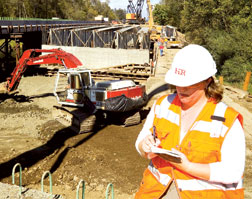...normally set up on a project,” says Ronaldo “Nick” Nicholson, VDOT project manager. “There were a lot of lessons learned.” VDOT also took over affected apartment buildings, investing $3 million in improvements and freezing rents. Relocation payments were made to 402 displacees; 65% used them to buy houses, says Bryan O’Sullivan, VDOT right-of-way and utilities manager.
 |
| Building Up. Las Vegas Highway 95 job moves forward after deal with Sierra Club. (Photo courtesy of Nevada Dept. of Transportation) |
In Las Vegas, another Sierra Club deal has Nevada Dept. of Transportation doing air quality mitigation. The $540-million, nine-mile U.S. 95 widening project is nearing completion after a one-year setback due to a 2002 lawsuit that cited studies linking vehicle emissions and cancer risks. NDOT settled out of court in 2005 and is installing air filters and monitors at local schools and retrofitting school buses.
DOTs don’t always have to pay. The final $160-million, 12-mile segment of Arizona’s 25-mile Santan Freeway features drainage basins-cum-parks, paid for by the Town of Gilbert. The town also worked with ADOT to create a pedestrian freeway crossing and four miles of trails. “The cities have stepped up and are willing to fund more elaborate designs in the name of quality of life,” says ADOT spokesman Doug Nitzel.
In the 1990s, some state transportation departments began adopting their own standards for highway design in response to growing demand for highway geometry that better reflects local sensibilities (ENR 1/13/98 p. 24). This meant departing, when needed, from the design guidelines of the AASHTO “Green Book.” Says Tom Warne, a consultant and former Utah DOT chief: “I tell young engineers that this is your opportunity to create solutions with the backdrop of the Green Book, but not counting on it as a solution to every problem.”
PB’s Chris Baca, who managed a 2002 example of CSS with New Mexico’s U.S.70 through the Hondo Valley, says more western states are putting out flexible design guidelines. Not only can flexibility result in a well-loved project, but in some cases, “it costs less because you don’t build out the road as much,” he says.
Massachusetts is completely overhauling its highway design procedures to truly integrate CSS and community involvement, says Chris Conklin, project manager for VHB, the project consultant. The pending document will tailor guidelines to specific state regions. “If you look in the Green Book, it characterizes terrain as flat, rolling or mountainous for slope guidance,” he says. “That breakout does not make sense for Massachusetts.”
 |
| Bold Goals. Oregon’s bridge program aims for eco-sensitive, economically sound and long-lasting retrofits. (Photo courtesy of HDR) |
With limited budgets, South Carolina and Louisiana are examples of states tackling CSS by hiring program managers to handle reconstruction of hundreds of highway bridges and expand relationships with stakeholders. One of the most ambitious examples is in Oregon, where a joint venture of HDR and Fluor Enterprises is managing the eight-year, $3-billion state bridge program. “Oregon took sustainability and married it with CSS,” says Jason Neil, deputy program director for Oregon Bridge Delivery Partners. The C3 program’s sustainable elements include recycling of road materials and retrofitting construction equipment, creating bid packages to suit local contractors, using long-lasting materials and creating a certification program for participating firms based on performance standards.
“The new approach represents a broader definition of ‘context’,” says David Goodyear, senior vice president with San Francisco-based T.Y. Lin International, one of the participating firms. “It includes not only the physical attributes of bridges in the context of their surroundings, but also the sociological context, the effects on the local economy, the transportation system during construction and the interaction of designers, builders and the public.”
 |
| Historic. New guidelines are under way for designing in context. (Photo courtesy of Otak Inc.) |
America’s highway system is now old enough to require historical preservation measures. Otak Inc., Portland, Ore., is leading a team that is writing a document, due next year, for the National Cooperative Highway Research Program. It will create specific guidelines for historic contexts and elements and flexible highway designs. “We hope that the work will eventually become an additional chapter for the Green Book,” says Mandi Roberts, Otak landscape architect. “The guidelines will specifically call for things you can do, using case examples of how designs have been flexibly applied.”
Segments of the Interstate system will also be eligible for National Register status. It has been exempted as a whole in anticipation of the 50th year, when preservation laws often go automatically into effect. Now, a team led by Columbus-based Battelle for FHWA is pinpointing specific segments that deserve to be designated as historically significant.
“We set up a framework to get collective knowledge of Interstates in each state,” says team member Richard Starzak, senior architectural historian with Jones & Stokes, Sacramento. Interstate segments are considered for historic listings based on engineering achievements, socio-cultural impacts, national landmark status and regional significance. The preliminary master list is now undergoing public comment, to be published by June 29, the Interstate anniversary.
One likely candidate is the I-70 Vail Pass in Colorado, completed in 1978. “It’s a historical milestone in the environmental movement,” notes Starzak. Another could well be I-40 through Overton Park, Tenn., where ’60s roadbuilders wanted to cut through historic areas. The resulting legal case set a precedent for public involvement in federal road projects. “It was an awakening,” says Peters. Although highway builders have come a long way since then, “we’re still at a steep part of the learning curve,” says Kassoff.

Post a comment to this article
Report Abusive Comment